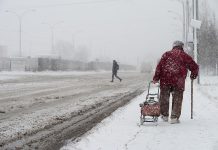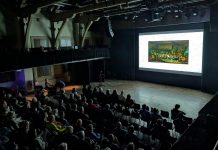
Eighty years after the U.S. dropped atomic bombs on the Japanese cities of Hiroshima and Nagasaki, a floating lantern commemoration will be held at 7:35 p.m. on Thursday (August 7) on the shores of Little Lake in downtown Peterborough.
Lantern ceremonies are held annually around the world in August to commemorate the atomic bombings of Hiroshima and Nagasaki. Participants gather to remember the victims, reflect on the devastation, and promote peace. The ceremonies usually involve the floating of lanterns on bodies of water, often accompanied by music, speeches, and other performances.
The Peterborough Peace Council has organized an annual floating lantern ceremony for many years. This year’s event is being organized by the Peterborough Quakers, many of whom are also members of the Peterborough Peace Council.
Taking place at the T-Wharf on Little Lake off Crescent Street, the commemoration will include brief reflections on war and the need to constantly work for peace, interspersed with music and peaceful reflection, followed by the floating of the lanterns on the waters of Little Lake.
“Participants are invited to bring their own reflections to share, or simply to hold in their hearts all those soldiers and civilians who have died and continue to die in war,” reads a media release from the Peterborough Peace Council.
Lanterns will be provided to attendees, but participants may wish to bring their own chairs or blankets.
“The floating lanterns commemoration is a gentle and beautiful grassroots way of helping us remember we can do many things to bring about a more peaceful world,” says organizing committee member Pat Gere.
In August 1945, in the final stages of World War II, the United States dropped two atomic bombs on Japan — the first and only use of nuclear weapons in war to date.
The atomic bomb was developed through the top-secret Manhattan Project, launched in the U.S. in 1942 in the belief that Nazi Germany was already working to develop an atomic bomb. Although Germany was nowhere near to completing a bomb when it surrendered in May 1945, the U.S. continued the project in an effort to force Japan’s swift surrender and avoid a prolonged invasion of the island by American soldiers.
The first bomb, Little Boy, was dropped on the city of Hiroshima on August 6, killing an estimated 70,000 people instantly and levelling much of the city. Three days later, on August 9, the U.S. dropped a second bomb, Fat Man, on Nagasaki, causing another 40,000 immediate deaths. The total number of deaths resulting from the bombings is estimated to be between 129,000 and 226,000 people, include those who died instantly as well as those who died later from injuries and radiation-related illnesses.
While the two bombings were the deciding factor in Japan’s decision to surrender unconditionally on August 15, 1945, bringing World War II to an end, their use was and continues to be highly controversial. Some argue that Japan was already close to surrender and that the bombings caused unnecessary civilian suffering, while others argue the bombings hastened the end of the war and saved more lives in the long term.
Along with their unprecedented destruction and loss of life, the dropping of the bombs marked the beginning of the nuclear age and the subsequent proliferation of nuclear weapons in multiple countries over the following decades.


























